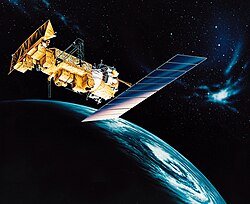 TIROS 5 satellite during inspection. | |
| Mission type | Weather satellite |
|---|---|
| Operator | NASA |
| Harvard designation | 1962 αα1 |
| COSPAR ID | 1962-025A |
| SATCAT no. | 309 |
| Mission duration | 11 months |
| Spacecraft properties | |
| Spacecraft type | TIROS |
| Manufacturer | RCA Astro / GSFC |
| Launch mass | 129.3 kilograms (285 lb) [1] |
| Start of mission | |
| Launch date | June 19, 1962, 12:14 UTC [2] |
| Rocket | Thor-Delta |
| Launch site | Cape Canaveral LC-17A |
| End of mission | |
| Last contact | May 14, 1963 |
| Orbital parameters | |
| Reference system | Geocentric |
| Regime | Low Earth |
| Eccentricity | 0.02695 [1] |
| Perigee altitude | 586 kilometers (364 mi) [1] |
| Apogee altitude | 972 kilometers (604 mi) [1] |
| Inclination | 58.08° [1] |
| Period | 100 minutes [1] |
| Epoch | June 19, 1962 [1] |
| Instruments | |
| Television Camera System | |
TIROS 5 (also called TIROS-E and A-50) was a spin-stabilized meteorological satellite. It was the fifth in a series of Television Infrared Observation Satellites.




